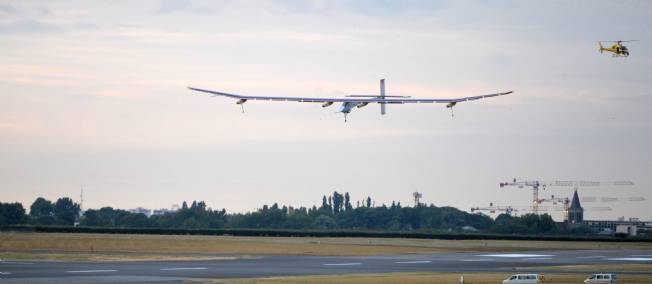Bonne nuit !
Tiens encore un avion Electrique de chez EADS !
L'Electroliner ! Peut être pas si éloigné !
Un projet, assez peu vu ou commenté que nous sors Ben Sandiland !
-------------- Le lien et un extrait ---------------
http://blogs.crikey.com.au/planetalking/2011/06/27/eads-vision-of-an-electroliner/
EADS vision of an ElectroLiner June 27, 2011 – 7:58 pm, by Ben Sandilands

EADS graphic of the all electric city-flyer of the 2030s
Although it was swept aside at the Paris Air Show last week by the
torrent of orders for the Airbus A320NEO, the manufacturer’s owner EADS’
proposal for an all-electric airliner may be what replaces them in the
2030s.
This is the first plan for a completely electric large airliner. It
is powered by what EADS regards as achievable electric battery
technology by the time the latest airliners in service today have run
out of relevance in a world where zero fossil carbon emissions will be
essential for all forms of mass transport.
In the basic plan below, liquid nitrogen is used to cool
superconducting electric motors driving contra-rotating shrouded
propellers at the end of an easy-load wide body cabin.

The essentials of the all electric airliners as proposed by EADS
While no range or payload claims were made by EADS, sources said the
concept was seen as plausible replacement for the single aisle designs
currently used for short to medium haul high frequency inter-city
routes, meaning 737s and A320s.
Jean Botti, Chief Technical Officer for EADS, said the capabilities
of today’s batteries and electric motors are far short of what is
theoretically possible, and realistically deliverable within 20 years.
Botti said high temperature superconducting materials were the key to
overcoming the limitations of conventional electric motors, and had the
potential to exceed the weight efficiency of gas turbine engines. He
said these HST electric motors were expected to reach power levels of
7-8 kW/kg and with almost no electrical losses by the 2030s.
The design envisages a completely removable battery bank, thus taking
from the fuselage and wing design all of the complexity of liquid fuel
tanks and distribution systems. The concept envisages that with all of
the battery maintenance and recharging conducted on the ground, the
replacement of the battery containers between flights would be achieved
in no more than the time conventional refuelling currently takes.
The broad ovaloid shape of the fuselage also houses all of the
undercarriage, allowing for a clean wing uncluttered by engine mountings
or wheel housings.
Just over a year ago Boeing, under contract to NASA, revealed its
hybrid electric SUGAR Volt design for a high wing 150 seat design. SUGAR
stands for subsonic ultra-green aircraft research, and some of the
proprietary information and supporting graphics were
published by Plane Talking and Aviation Week after they were inadvertently placed in the public domain.
The Boeing proposal is better explained in that article than the EADS
proposal, and like a hybrid automobile today, seeks to convert kinetic
energy into battery recharging, hopefully with more efficiency than such
cars today
.-------------
JPRS






